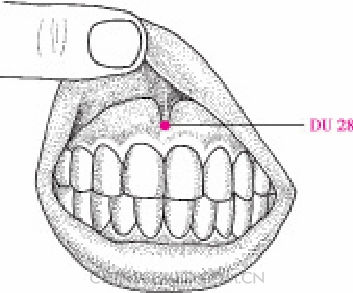- DU 1 (Cháng Qiáng, 长强)
- DU 2 (Yāo Shù, 腰俞)
- DU 3 (Yāo Yáng Guān, 腰阳关)
- DU 4 (Mìng Mén, 命门)
- DU 5 (Xuán Shū, 悬枢)
- DU 6 (Jǐ Zhōng, 脊中)
- DU 7 (Zhōng Shū, 中枢)
- DU 8 (Jīn Suō, 筋缩)
- DU 9 (Zhì Yáng, 至阳)
- DU 10 (Líng Tái, 灵台)
- DU 11 (Shén Dào, 神道)
- DU 12 (Shēn Zhù, 身柱)
- DU 13 (Táo Dào, 陶道)
- DU 14 (Dà Zhuī, 大椎)
- DU 15 (Yǎ Mén, 哑门)
- DU 16 (Fēng Fǔ, 风府)
- DU 17 (Nǎo Hù, 脑户)
- DU 18 (Qiáng Jiān, 强间)
- DU 19 (Hòu Dǐng, 后顶)
- DU 20 (Bǎi Huì, 百会)
- DU 21 (Qián Dǐng, 前顶)
- DU 22 (Xìn Huì, 囟会)
- DU 23 (Shàng Xīng, 上星)
- DU 24 (Shén Tíng, 神庭)
- DU 25 (Sù Liáo, 素髎)
- DU 26 (Shuǐ Gōu, 水沟)
- DU 27 (Duì Duān, 兑端)
- DU 28 (Yín Jiāo, 龈交)
There are 28 points on the du mai. The channel begins in the lower abdomen and runs along the spine to the nape of the neck, head, and face. The first point is between the coccyx and the anus, DU 1 (cháng qiáng); the last is in the mouth at the upper gum, DU 28 (yín jiāo). Indications for the du mai and its points include brain and nervous, respiratory, digestive, urinary, and reproductive system disorders and those of the running course.
DU 1 (Cháng Qiáng, 长强)
Intersecting point of the du, foot shaoyang, and foot shaoyin channels; luo-connecting point of the du mai
Location. In the perineal region below the coccyx and midway between the tip of the coccyx and the anus (Pic. 3-91).
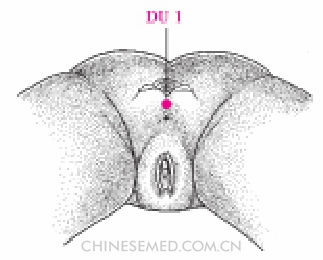
Location.method. With the patient prone or in kneechest position, the point is in the depression at the midpoint between the tip of the coccyx and the anus.
Actions. Nourish yin and suppress excess yang, and boost qi to prevent collapse.
Indications. Hemorrhoids, prolapsed anus, bloody stool, diarrhea, constipation, other intestinal disorders; depression, mania, other mental and brain disorders; epilepsy; low back pain, sacrum and coccyx pain.
Manipulation. Acupuncture: 1. Needle obliquely and slowly upward 0.5~1.0 cun, between the sacrum and the rectum. Local soreness and distention may be felt and can radiate to the anus and coccyx. The needling sensation may spread to the waist along the du mai or to DU 20 (băi huì). 2. Prick to bleed using a three-edged needle; some patients might feel a sensation in the anterior aspect of the coccyx. Perpendicular insertion is prohibited to prevent injury to the rectum. Moxibustion: Moxa is not usually applied.
Precautions. Do not penetrate the rectum as that might cause inflammation.
Annotation. The point appeared in The Spiritual Pivot-Fundamental Points (Líng Shū-Běn Shū,灵枢·本输). It is the luo-connecting point of the du mai, which travels along the spinal column. The spine is long and strong; of all the channels, the du mai has the most yang. Thus, the point is named cháng qiáng, long strong.
Modern clinical observation and research. In an RCT on the efficacy of acupuncture plus anesthetics in hemorrhoid surgery and its postoperative complications, 40 patients were given EA, 2 Hz/100 Hz, 9 mA, at DU 1 (cháng qiáng) and DU 2 (yāo shù) for 20 min plus 5 ml 1% lidocaine or lidocaine only (n=20/each group). The first group received 5 ml of 1% lidocaine at DU 1; control got 20 ml and 10 ml of 1% lidocaine at DU 2 and DU 1, respectively. Analgesic efficacy was not significantly different in two groups during surgery (P>0.05). The EA group experienced significantly less urinary retention after surgery (P<0.05).1
DU 2 (Yāo Shù, 腰俞)
Location. In the sacral hiatus on the posterior median line (Pic. 3-92).
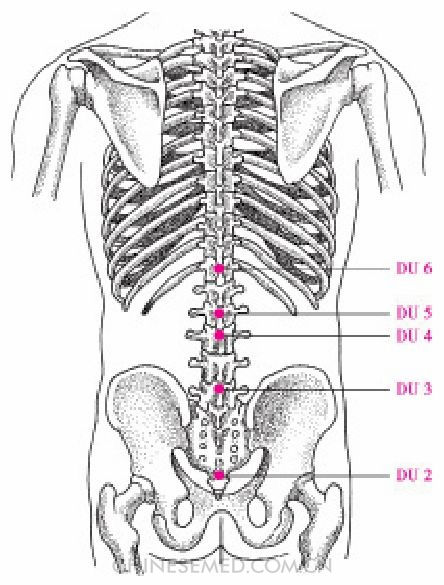
Location.method. With the patient prone, find the sacral hiatus, a small depression immediately above the anal cleft; the point is on the posterior midline at the level of the inferior border of the sacral cornua.
Actions. Reinforce the kidney to regulate menstruation, and strengthen the muscles and bones.
Indications. Diarrhea, constipation, bloody stool, hemorrhoids, prolapsed anus, other intestinal disorders; irregular menstruation, amenorrhea, other menstrual disorders; depression, mania, other mental disorders; epilepsy; low back pain, coccyx pain, spine and back stiffiness and pain.
Manipulation. Acupuncture: Needle obliquely upwards 0.5~1.0 cun. Local soreness and distention should be felt and should radiate to the lumbar and sacrum. Moxibustion: Use 3~5 cones of cone moxibustion, or use a moxa stick for 5~10 minutes.
Annotation. The point appeared in BasicQuestions-On Contralateral Shallow CollateralNeedling (Sù Wèn-Miù Cì Lùn, 素问·缪刺论). It is named yāo shù, lumbar shu, for its location in the sacral hiatus.
Modern clinical observation and research. See DU 1.
DU 3 (Yāo Yáng Guān, 腰阳关)
Location. In the lumbar region on the posterior median line in the depression inferior to the spinous process of the fourth lumbar vertebra (Pic. 3-92).
Location.method. With the patient prone, the spinous process of L4 is at the midpoint of the highest point of the iliac crests.
Actions. Reinforce kidney qi, and strengthen the waist and the kidney.
Indications. Low back pain, numb lower extremities; spermatorrhea, impotence, other andrological disorders; irregular menstruation, morbid leukorrhea, other gynecological disorders.
Manipulation. Acupuncture: Needle perpendicularly or obliquely 0.5~1.0 cun; local soreness and distention might be felt and numbness and an electric-like sensation will radiate to the lower limbs. Moxibustion: Use 3~7 cones of cone moxibustion, or use warming needle moxibustion for 20 minutes, or use a moxa stick for 10~20 minutes.
Annotation. The point appeared in Basic Questions-Treatise on Qi Mansion (Sù Wèn-Qì Fǔ Lùn,素问·气府论). Because it is on the du mai, the ‘sea of yang channels’, it boosts the yang qi of the whole body, strengthens the back, and is called yāo yáng guān, lumbar yang gate.
DU 4 (Mìng Mén, 命门)
Location. In the lumbar region on the posterior median line in the depression inferior to the spinous process of the second lumbar vertebra (Pic. 3-92).
Actions. Secure essence and tonify yang, and nourish original qi to reinforce the kidney.
Indications. Irregular menstruation, morbid leukorrhea, dysmenorrhea, amenorrhea, infertility, other gynecological disorders; spermatorrhea, impotence, infertility, other kidney yang deficiency disorders in men; enuresis, difficult urination, diarrhea, other urine and stool disorders; low back pain, spinal stiffiness and pain, atrophy, paralysis of the legs, other disorders of the lower limbs.
Manipulation. Acupuncture: Needle perpendicularly or obliquely 0.5~1.0 cun; local soreness and distention might be felt. When it is needled deeply, numbness and an electric-like sensation will travel to the buttocks and lower limbs. Moxibustion: Use 5~7 cones of cone moxibustion, or use warming needle moxibustion for 20 minutes, or use a moxa stick for 10~20 minutes. Medicinal and natural moxibustion may also be used, and scarring or fù zĭ moxibustion (moxibustion with Radix Aconiti Lateralis Praeparata) may be used to strengthen the body and promote health.
Precautions. In order to prevent spinal cord damage, oblique and deep needling is prohibited. If the spinal cord is injured, the following symptoms may occur: paralysis, sensory disorder of the muscles of the lower limbs, and urinary incontinence. When needling too deeply, there will be no obstruction at the needle tip, and strong electric-like sensations will radiate to the patient’s lower limbs, indicating that the needle has pierced the subarachnoid space. In children, needling below the spinal dura mater is prohibited.
Annotation. The point appeared in The Systematic Classic of Acupuncture and Moxibustion (ZhēnJiŭ Jiă Yĭ Jīng, 针灸甲乙经). Located below the spinous process of the second lumbar vertebra in the area of original qi and the gate of life, the point is called mìng mén, life gate.
DU 5 (Xuán Shū, 悬枢)
Location. In the lumbar region at the posterior median line in the depression inferior to the spinous process of the first lumbar vertebra (Pic. 3-92).
Actions. Strengthen the waist and kidney.
Indications. Stiffiness and lumbar pain; abdominal pain and diarrhea.
Manipulation. Acupuncture: Needle perpendicularly or obliquely 0.5~1 cun. Use twirling to reinforce or reduce. Local soreness or distention might be felt. Moxibustion: Use 3~7 cones of cone moxibustion, or use warming needle moxibustion for 20 minutes, or use a moxa stick for 5~15 minutes.
Precautions. See DU 4 (mìng mén).
Annotation. The point appeared in The Systematic Classic of Acupuncture and Moxibustion (ZhēnJiŭ Jiă Yĭ Jīng, 针灸甲乙经). Xuán means hanging; shū means pivot. The point is in the depression below the spinous process of the first lumbar vertebra between left and right BL 22 (sān jiāo shù). The sanjiao is pivotal in the movement of qi and governs qi transformation. Thus the point was named xuán shū, hanging pivot.
DU 6 (Jǐ Zhōng, 脊中)
Location. On the upper back at the posterior median line in the depression inferior to the spinous process of the 11th thoracic vertebra (Pic. 3-92).
Actions. Regulate the stomach and intestines, reinforce the kidney, and calm the spirit.
Indications. Diarrhea, dysentery, hemorrhoids, prolapsed anus, bloody stool, other intestinal disorders; jaundice; epilepsy; lumbar stiffiness and pain.
Manipulation. Acupuncture: Needle obliquely upward 0.5~1.0 cun; twirl. Local soreness and distention might be felt. When the point is needled deeply, electric-like sensations can radiate to the lower limbs. Moxibustion: Use 3~7 cones for cone or warming needle moxibustion, or use a moxa stick for 5~15 minutes.
Precautions. Insert upward and obliquely between the thoracic spinous processes. Needling too deeply will cause the needle to touch the spinal dura mater, inducing electric-like sensations and possibly causing unnecessary pain and injury.
Annotation. The point appeared in The Systematic Classic of Acupuncture and Moxibustion (ZhēnJiŭ Jiă Yĭ Jīng, 针灸甲乙经). Jĭ means spinal vertebra; zhōng means midpoint. The point is below the spinous process of the 11th thoracic vertebra in the middle of the spinal column. Therefore it is called jǐ zhōng, spine midpoint.
DU 7 (Zhōng Shū, 中枢)
Location. On the upper back at the posterior median line in the depression inferior to the spinous process of the tenth thoracic vertebra (Pic. 3-93).
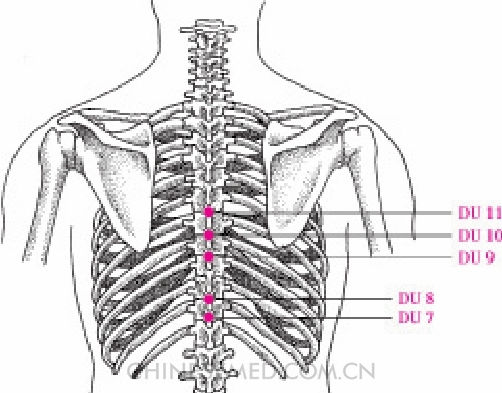
Actions. Strengthen the lower back and tonify the kidney, and harmonize the stomach to relieve pain.
Indications. Jaundice; vomiting, distention of the abdomen, stomach pain, poor appetite; lumbar and back pain.
Manipulation. Acupuncture: Needle obliquely upward 0.5~1.0 cun. Local soreness and distention might be felt; with deep needling, numbness and electric-like sensations can radiate to the lower limbs.
Precautions. See DU 6 (jǐ zhōng).
Annotation. The point appeared in Basic Questions-Treatise on Qi Mansion (Sù Wèn-Qì FǔLùn, 素问·气府论). Shū means pivot, and the point is near the midpoint of the spine at the pivot of movement. Therefore, it is called zhōng shū, midpoint pivot.
DU 8 (Jīn Suō, 筋缩)
Location. On the upper back at the posterior median line in the depression inferior to the spinous process of the ninth thoracic vertebra (Pic. 3-93).
Actions. Relax sinews, tonify yang, awaken the mind, and calm the spirit.
Indications. Convulsion, stiffiness of the spine, flaccidity, spasm of the four limbs; epilepsy; jaundice; stomach pain.
Manipulation. Acupuncture: Needle obliquely upward 0.5~1.0 cun. Local soreness and distention might be felt. Moxibustion: Use 5~7 cones of direct moxibustion, or use a moxa stick for 10~15 minutes.
Precautions. See DU 6 (jǐ zhōng).
Annotation. The point appeared in The Systematic Classic of Acupuncture and Moxibustion (Zhēn Jiŭ Jiă Yĭ Jīng, 针灸甲乙经). Located in the depression below the spinous process of the ninth thoracic vertebra, the point is between right and left BL 18 (gān shù). The liver is responsible for sinews; the point treats disorders due to spasms and contractions of the sinews, so it is called jīn suō, sinew contraction.
DU 9 (Zhì Yáng, 至阳)
Location. On the upper back at the posterior median line in the depression inferior to the spinous process of the seventh thoracic vertebra (Pic. 3-93).
Location.method. With the patient prone and the arms beside the body, the point is at the level of the inferior angle of the scapula in the depression below the spinous process of the seventh thoracic vertebra between left and right BL 17 (gé shù).
Actions. Drain dampness and relieve jaundice, fortify the spleen, harmonize the stomach, and relieve cough and panting.
Indications. Distending sensation in chest and hypochondrium, jaundice, abdominal pain, cough, asthma, back and waist pain, distention and fullness, stiff spine.
Manipulation. Acupuncture: Needle obliquely upward 0.5~1.0 cun. Local soreness and distention might be felt and can radiate to the lower back or the chest. Moxibustion: Use 3~7 cones of cone moxibustion, or use warming needle moxibustion for 20 minutes, or use a moxa stick for 10~20 minutes.
Precautions. See DU 6 (jǐ zhōng).
Annotation. The point appeared in Systematic Classic of Acupuncture and Moxibustion (ZhēnJiŭ Jiă Yĭ Jīng, 针灸甲乙经). Zhì means utmost. The back of the body belongs to yang; the area below the diaphragm is more yin and that above the diaphragm is more yang. The point is in the region belonging to yang, so it is called zhì yáng, utmost yang.
DU 10 (Líng Tái, 灵台)
Location. On the upper back at the posterior median line in the depression inferior to the spinous process of the sixth thoracic vertebra (Pic. 3-93).
Actions. Clear heat and eliminate toxins, diffuse the lung and relieve panting, relax sinews and quicken collaterals.
Indications. Furuncles; cough, asthma; stiffiness of spine, back pain.
Manipulation. Needle obliquely upward 0.5~1.0 cun. Local soreness and distention can radiate to the lower back or the chest. Moxibustion: Use 3~7 cones of cone moxibustion, or use warming needle moxibustion for 20 minutes, or use a moxa stick for 10~20 minutes.
Precautions. See DU 6 (jǐ zhōng).
Annotation. The point appeared in Basic Questions-Treatise on Qi Mansion (Sù Wèn-Qì Fǔ Lùn,素问·气府论). Líng means soul; tái means platform, a place where the ancient emperors preached about proper human behavior and social practices, which are functions of the human soul. The point is in the depression below the spinous process of the sixth thoracic vertebra, which corresponds to the position of the heart, the locus of the soul. Hence the name líng tái, soul platform.
DU 11 (Shén Dào, 神道)
Location. On the upper back at the posterior median line in the depression inferior to the spinous process of the fifth thoracic vertebra between left and right BL 15 (xīn shù) (Pic. 3-93).
Actions. Suppress fright, calm the mind, rectify qi and loosen the chest.
Indications. Palpitations due to fright, severe palpitations, insomnia, amnesia, other mental disorders; epilepsy, aphonia due to stroke; cough and asthma; stiffiness of waist and spine, shoulder and back pain.
Manipulation. Acupuncture: Needle obliquely upward 0.5~1.0 cun. Local soreness and distention can spread to the lower back or the chest. Moxibustion: Use 3~7 cones of cone moxibustion, or use warming needle moxibustion for 20 minutes, or use a moxa stick for 5~15 minutes.
Precautions. See DU 6 (jǐ zhōng).
Annotation. The point appeared in The Systematic Classic of Acupuncture and Moxibustion (ZhēnJiŭ Jiă Yĭ Jīng, 针灸甲乙经). Its location corresponds to the heart, which stores the spirit. Heart qi flows at this point, which can be used to treat mental disorders and thus is called shén dào, spirit passage.
DU 12 (Shēn Zhù, 身柱)
Location. On the upper back at the posterior median line in the depression inferior to the spinous process of the third thoracic vertebra (Pic. 3-94).
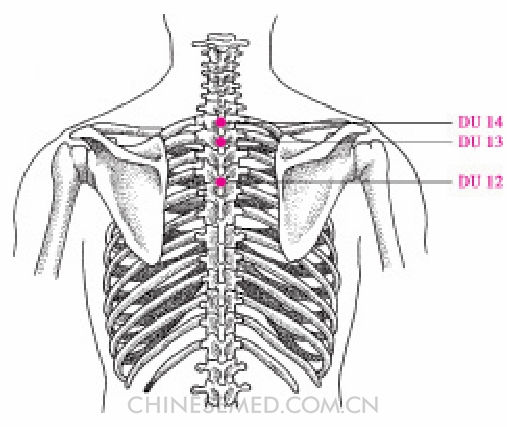
Location.method. With the patient prone, the point is at the intersection of the posterior median line and a horizontal line from the medial end of the scapular spine in the depression below the spinous process of the third thoracic vertebra.
Actions. Clear heat and diffuse the lung, awaken the spirit, suppress convulsions, invigorate blood, and unblock collaterals.
Indications. Cough, asthma, fever, headache, other externally-contracted diseases; convulsion, depressive psychosis, mania, other mental conditions; furuncles on the back; stiffiness and pain of the spine and back.
Manipulation. Acupuncture: Needle obliquely upward 0.5~1.0 cun. Local soreness and distention might be felt. The needle should be withdrawn immediately if soreness, distention, or heaviness runs along the du mai to the sacral region or other parts of the body. Moxibustion: Use 3~7 cones of cone moxibustion, or use warming needle moxibustion for 20 minutes, or use a moxa stick for 10~20 minutes. Perform warming moxibustion until the skin turns slightly red to strengthen the body and promote health.
Precautions. See DU 6 (jǐ zhōng).
Annotation. The point appeared in The Systematic Classic of Acupuncture and Moxibustion (ZhēnJiŭ Jiă Yĭ Jīng, 针灸甲乙经). It is in the depression below the spinous process of the third thoracic vertebra, like a column supporting the weight of the two scapulas. Thus it is called shēn zhù, body column.
DU 13 (Táo Dào, 陶道)
Intersecting point of du mai and the foot taiyang channel
Location. On the upper back at the posterior median line in the depression inferior to the spinous process of the first thoracic vertebra (Pic. 3-94).
Location.method. With the patient prone, locate DU 14 (dà zhuī). The point is in the depression one spinous process below DU 14.
Actions. Clear heat to release the exterior, calm the mind, prevent malaria attack, relax sinews, and unblock collaterals.
Indications. Headache and stiffiness of the nape, aversion to cold with fever, cough, asthma, other externally-contracted diseases; depression, mania, opisthotonos; steaming bone fever, tidal fever; sore spine and back.
Manipulation. Acupuncture: Needle obliquely upward 0.5~1.0 cun. Local soreness and might radiate downward toward the shoulder and the arms or throughout the body. Moxibustion: Use 3~7 cones of cone moxibustion, or use warming needle moxibustion for 20 minutes, or use a moxa stick for 10~20 minutes.
Precautions. See DU 6 (jǐ zhōng).
Annotation. The point appeared in The Systematic Classic of Acupuncture and Moxibustion (ZhēnJiŭ Jiă Yĭ Jīng, 针灸甲乙经). Táo means pottery kiln. Channel qi passes through this point like fre passes through a kiln. Therefore the point is called táo dào, kiln passage.
DU 14 (Dà Zhuī, 大椎)
Intersecting point of the six yang channels and the du mai
Location. On the neck at the posterior median line in the depression inferior to the spinous process of the seventh cervical vertebra (Pic. 3-94).
Location.method. With the patient prone or sitting with the head bent, the most prominent site on the posterior aspect of the neck is the spinous process of the seventh cervical vertebra. It is the vertebra that moves when the head rotates, bends, or extends.
Actions. Release the exterior, dissipate cold, suppress fright, calm the mind, disperse the lung to regulate qi, clear heat, and eliminate toxins.
Indications. Aversion to cold and fever, cough, asthma, stiffiness and pain of head and nape, shoulder and back pain, other externally-contracted diseases; depression, mania, other mental conditions; epilepsy, infantile convulsions; rubella, acne; steaming bone fever, tidal fever; stiff neck, opisthotonos, shoulder and nape pain.
Manipulation. Acupuncture: 1. With the patient prone, slowly needle perpendicularly 0.8~ 1.2 cun, without strong lifting or thrusting. Local soreness, numbness, and an electric-like sensation might radiate to the lower part of the spine or upward to the neck. 2. Insert the needle as in the previous method and lift it to the subcutaneous layer, needling toward the acromion on both sides at an angle of 25~40 degrees or needle obliquely toward the medial border of the scapula 0.8~1.2 cun so that the needling sensation radiates to the shoulder and arms. 3. Needle subcutaneously so that the needling sensation spreads upward or downward. 4. Bleed with a three-edged needle. Moxibustion: Use 5~9 cones of cone moxibustion, or use warming needle moxibustion for 20 minutes, or use a moxa stick for 10~20 minutes. Medicinal moxibustion may be used. Scarring moxibustion may be done once a year to strengthen the body and promote health.
Precautions. The needle should be inserted along the spinous process. Stop needling if obstruction suddenly disappears and there is a feeling of emptiness below the needle tip. This indicates that the tip has touched the outer cavity of the dura mater of the spinal canal. If the patient suddenly moves during acupuncture, the needle should be withdrawn immediately. This is to prevent injury to the spinal cord. The du mai is the convergence of all yang channels; it treats disorders in those channels. Needling depth is usually more than 1 cun. It is important for qi to arrive at the affected area; otherwise efficacy is decreased or the treatment will be ineffective.
Annotation. The point appeared in Basic Questions-Treatise on Bone Cavity (Sù Wèn-Gǔ KōngLùn, 素问·骨空论). Located in the depression below the spinous process of the largest vertebra, it is called dà zhuī, great vertebra.
DU 15 (Yǎ Mén, 哑门)
Intersecting point of du mai and yangwei mai
Location. On the neck at the posterior median line in the depression superior to the spinous process of the second cervical vertebra (Pic. 3-95).
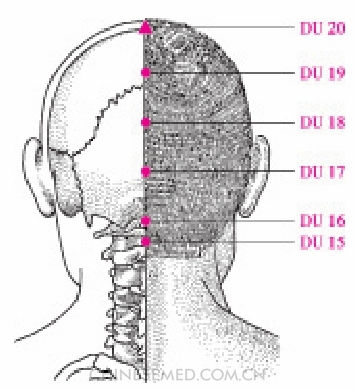
Location.method. With the patient tilting the head slightly downward, the point is 0.5 cun above the posterior hairline on the posterior midline.
Actions. Recover the voice, relieve the stuffy orifices, decrease heart fre, and calm the mind.
Indications. Sudden aphonia, inability to speak due to stiff tongue, other mouth and tongue disorders; headache, stiff neck and spine, other head and nape disorders; epilepsy; depression, mania, other mental conditions.
Manipulation. Acupuncture: Needle perpendicularly or obliquely downward 0.5~0.8 cun. Moxibustion: Do not use cone moxibustion at this point. Use a moxa stick for 3~5 minutes.
Precautions. Take special care when needling this point. The maximum needling depth is 1.5 cun. Stop insertion when the needle arrives at the outer layer of the dura mater. Do not needle obliquely upward or toward the nose. This is to avoid the medulla, which is central to life. If the patient experiences numbness and electric-like sensations, withdraw the needle immediately and do not lift, thrust or twirl it. Cone moxibustion is forbidden here.
Annotation. The point appeared in Basic Questions-Treatise on Acupoints (Sù Wèn-Qì Xué Lùn,素问·气穴论). Yă means muteness. This is an effective point for treating inability to speak and loss of voice, so it is called yǎ mén, gate of muteness.
DU 16 (Fēng Fǔ, 风府)
Intersecting point of du mai and yangwei mai
Location. On the neck directly below the external occipital protuberance in the depression between the trapezius muscles (Pic. 3-95).
Location.method. With the patient seated, head tilted slightly downward, push up from the midpoint of the posterior hairline to the occipital bone to fnd the point.
Actions. Clear heat and extinguish wind, awaken the mind, and open the orifices.
Indications. Taiyang wind-invasion, headache, quivering with cold, sweating, other Externally-contracted diseases; neck stiffiness and pain, dizziness, nasal obstruction, nasal bleeding, sore throat, aphonia due to stiff tongue, other disorders of the head, neck and five sensory organs; epilepsy, stroke; depression, mania, other mental conditions.
Manipulation. Acupuncture: Ask the patient to sit propped on the elbows with head tilted slightly downward to relax the neck muscles. Slowly needle 0.5~1.0 cun toward the mandible. Moxibustion: Use a moxa stick for 3~5 minutes.
Precautions. Needling depth depends on the circumference of the patient’s neck. Withdraw the needle and do not manipulate once the patient experiences numbness and electric-like sensations. There are two sensations of obstruction when the needle is inserted deeply. One is when the needle penetrates the nuchal ligament, after which there is a sense of emptiness; the other is when the needle is at the dura mater. To prevent injury to the medulla and thus to life, do not needle deeply, perpendicularly, or obliquely upward or pierce the dura mater. Excessive lifting, thrusting, or twirling is prohibited, as is cone moxibustion.
Annotation. The point appeared in Basic Questions-Treatise on Bone Cavity (Sù Wèn-Gǔ KōngLùn, 素问·骨空论). Fŭ means house. Because this point is the gathering place of pathogenic wind and is indicated for all types of disorders caused by wind, it is called fēng fǔ, wind house.
DU 17 (Nǎo Hù, 脑户)
Intersecting point of du mai and the foot taiyang channel
Location. On the head in the depression superior to the external occipital protuberance (Pic. 3-95).
Actions. Clear the head to improve vision, suppress convulsion, and calm the mind.
Indications. Depression, mania, other mental disorders; epilepsy, headache, heaviness of the head, dizziness, stiff neck, other disorders of the head and neck; aphonia.
Manipulation. Acupuncture: Needle transversely 0.5~0.8 cun; distending pain may be felt at the local area. Moxibustion: Use a moxa stick for 5~10 minutes.
Annotation. The point appeared in Basic Questions-The Forbidden Position in Needling (SùWèn-Cì Jìn Lùn, 素问·刺禁论). Located in the depression directly superior to the external occipital protuberance, it corresponds to the brain marrow internally, so it is called nǎo hù, brain gate.
DU 18 (Qiáng Jiān, 强间)
Location. On the head 4 cun above the posterior hairline on the posterior median line (Pic. 3-95).
Location.method. Find the external occipital protuberance at the posterior of the head, then fnd the depression on the upper border. The point is 1.5 cun above the depression.
Actions. Calm the heart and mind, unblock collaterals, and relieve pain.
Indications. Headache, dizziness, stiff neck; depression, mania; epilepsy.
Manipulation. Acupuncture: Needle transversely 0.5~0.8 cun; distending pain might be felt. Moxibustion: Use a moxa stick for 5~10 minutes.
Annotation. The point appeared in The Systematic Classic of Acupuncture and Moxibustion (ZhēnJiŭ Jiă Yĭ Jīng, 针灸甲乙经). Jiān means opening. The point is at the inferior border of the occiput, so it is called qiáng jiān, strong opening.
DU 19 (Hòu Dǐng, 后顶)
Location. On the head at the posterior median line, 5.5 cun superior to the posterior hairline (Pic. 3-95).
Location.method. With the patient sitting or supine, the point is 0.5 cun posterior to the midpoint of a line connecting the anterior and posterior hairline.
Actions. Clear heat and relieve pain, and calm the heart and mind.
Indications. Headache, dizziness, stiff neck; depression, mania; epilepsy.
Manipulation. Acupuncture: Needle transversely 0.5~0.8 cun. Local distending pain might be felt. Moxibustion: Use a moxa stick for 5~10 minutes.
Annotation. The point appeared in The Systematic Classic of Acupuncture and Moxibustion (Zhēn Jiŭ Jiă Yĭ Jīng, 针灸甲乙经). Dĭng means peak. The point is posterior to DU 20 (bǎi huì) and is mainly indicated for disorders of the posterior area of the head. It is called hòu dǐng, back’s peak.
DU 20 (Bǎi Huì, 百会)
Intersecting point of hand and foot yang channels, foot jueyin channel, and the du mai
Location. On the head at the anterior median line, 5 cun superior to the anterior hairline (Pic. 3-96).
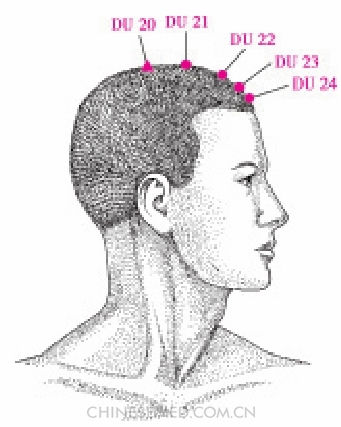
Location.method. With the patient sitting, the point is 1 cun anterior to the midpoint of a line connecting the anterior and posterior hairline.
Actions. Raise yang and rescue from collapse, open the orifce, and calm the mind.
Indications. Stroke, spasms, epilepsy; dementia, palpitations due to fright, hysteria, insomnia, forgetfulness, other mental disorders; headache, dizziness, other head and face conditions; prolapse of anus, rectum, or uterus; other disorders due to failure of qi to consolidate.
Manipulation. Acupuncture: 1. Needle transversely 0.5~0.8 cun. Local distending pain can be felt. 2. Insert toward sì shén cōng (EX-HN 1); the needling sensation can spread to the top of the cranium. Moxibustion: Use 7~15 cones of cone moxibustion, or use a moxa stick for 10~20 minutes. To strengthen the body and promote health, use 3~5 cones of ginger moxibustion or use a moxa stick.
Annotation. The point appeared in The Systematic Classic of Acupuncture and Moxibustion (ZhēnJiŭ Jiă Yĭ Jīng, 针灸甲乙经). This is the intersecting point of the hand and foot yang, foot jueyin, and du channels. It is indicated for many disorders, so it is called bǎi huì, hundred convergences.
Modern clinical observation and research. In an RCT comparing exercise plus acupuncture at scalp acupuncture zone anterior oblique line of vertex-temporal lobe (the motor zone), lower lateral line of occiput (the balance zone), and posterior oblique line of vertex-temporal lobe (the sensory zone) and at DU 20 (băi huì) and sì shén cōng (EX-HN 1) to exercise alone in children with spastic cerebral palsy (n=40/each group). The total effective rate was 92.5% in the acupuncture plus exercise group, a significant difference in motor function improvement compared to 72.5% in the exercise group (P<0.05).1
1 Ji YH, Sun BD, Zhang J, Zhang R, Ji YH. Therapeutic effect of scalp-acupuncture combined with exercise therapy on spastic cerebral palsy of the child头针配合运动疗法治疗痉挛型脑瘫患儿疗效观察. Chinese Acupuncture & Moxibustion. 2008; 28(10): 723-6.
DU 21 (Qián Dǐng, 前顶)
Location. On the head at the anterior median line 3.5 cun superior to the anterior hairline (Pic. 3-96).
Location.method. The point is midway between DU 20 (bǎi huì) and DU 22 (xìn huì).
Action. Clear heat and relieve stuffy orifices, fortify and calm the mind.
Indications. Depression, mania, other mental disorders; epilepsy, infantile convulsions, headache, vertigo, eye swelling and pain, nasosinusitis, other head and face disorders.
Manipulation. Acupuncture: Needle transversely 0.3~0.5 cun; local heaviness and distention might be felt. Moxibustion: Use 3~5 cones of cone moxibustion, or use a moxa stick for 5~10 minutes.
Precautions. It is forbidden to needle or moxa this point in infants whose fontanel has not closed or has recently closed.
Annotation. The point appeared in The Systematic Classic of Acupuncture and Moxibustion (ZhēnJiŭ Jiă Yĭ Jīng, 针灸甲乙经). Dĭng means peak of the head. The point is anterior to the peak of the head and is mainly indicated for conditions and disorders of the anterior part of the head. Therefore, it is called qián dǐng, anterior peak.
DU 22 (Xìn Huì, 囟会)
Location. On the head at the anterior median line, 2 cun superior to the anterior hairline (Pic. 3-96).
Actions. Awaken the mind, open the orifices, clear heat in the head, and disperse wind.
Indications. Depression, mania, other mental disorders; epilepsy, infantile convulsions, headache, dizziness, eye swelling and pain, nasosinusitis, other head and face disorders.
Manipulation. Acupuncture: Needle transversely 0.3~0.5 cun. Local distending pain might be felt. Do not needle any infant whose fontanel has not closed. Moxibustion: Use a moxa stick for 5~10 minutes.
Precautions. See DU 21 (qián dǐng).
Annotation. The point appeared in The Spiritual Pivot-Febrile Diseases (Líng Shū-Rè Bìng, 灵枢·热病). Xìn means fontanel, which is where the coronal skull and sagittal suture meet. The point is called xìn huì, fontanel meeting.
DU 23 (Shàng Xīng, 上星)
Location. On the head at the anterior median line, 1 cun superior to the anterior hairline (Pic. 3-96).
Actions. Disperse wind and clear heat, calm the heart, and relieve stuffy orifices.
Indications. Headache, vertigo, eye swelling and pain, lacrimation induced by irritation from wind, swelling of the face, nasosinusitis, nosebleed, painful nose, other disorders of the head and face; depression, mania, other mental conditions; infantile convulsions, febrile diseases, malaria.
Manipulation. Acupuncture: Needle transversely 0.3~0.5 cun. Local distending pain might be felt. Moxibustion: Use a moxa stick for 5~10 minutes.
Precautions. See DU 21 (qián dǐng).
Annotation. The point appeared in The Systematic Classic of Acupuncture and Moxibustion (ZhēnJiŭ Jiă Yĭ Jīng, 针灸甲乙经). Located on the skull, it brightens eyes, making them shine like stars in the sky. Therefore it is called shàng xīng, upper star.
DU 24 (Shén Tíng, 神庭)
Intersecting point of the foot taiyang, foot yangming, and du mai
Location. On the head at the anterior median line, 0.5 cun superior to the anterior hairline (Pic. 3-96).
Location.method. If the anterior hairline is unclear or changed, locate the point 3.5 cun above the point midway between the medial ends of the eyebrows.
Actions. Subdue yang and calm the mind, awaken the brain, and extinguish wind.
Indications. Depression, mania, insomnia, other mental disorders; epilepsy; headache, dizziness, nasosinusitis, nosebleed, nasal obstruction, eye swelling and pain, conjunctival congestion, night blindness, protruding tongue, corneal opacity, other disorders of the head, face, and five sensory organs.
Manipulation. Acupuncture: Needle transversely 0.3~0.5 cun; local distending pain can be felt. Moxibustion: Use a moxa stick for 5~10 minutes.
Precautions. Scarring moxibustion is prohibited.
Annotation. The point appeared in The Systematic Classic of Acupuncture and Moxibustion (ZhēnJiŭ Jiă Yĭ Jīng, 针灸甲乙经). The brain is the house of original spirit. This point is on the forehead, which is called ‘heaven’s palace’, so it is called shén tíng, spirit courtyard.
Modern clinical observation and research. In a case study of 110 patients with insomnia, acupuncture once a day at DU 24 (shén tíng) and DU 20 (bǎi huì) was compared to a sleeping medication control. Twelve treatments constituted a course, and two courses were administered. The overall effective rate was 91.81% in the treatment group; 57.78% in control, a significant difference (P<0.01).1
DU 25 (Sù Liáo, 素髎)
Location. On the face at the tip of the nose (Pic. 3-97).
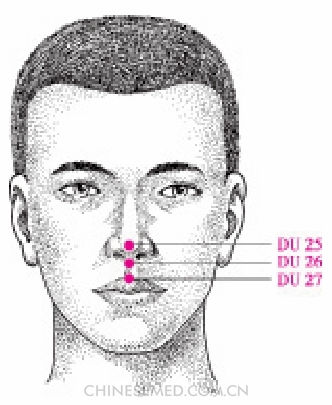
Actions. Relieve stuffy nose, open the orifices, and awaken the spirit.
Indications. Fainting due to fright, unconsciousness, infantile apnea, shock, other emergency disorders; nasosinusitis, nosebleed.
Manipulation. Acupuncture: 1. Needle obliquely upward 0.3~0.5 cun; local distending pain can radiate to the root of the nose. 2. Bleed with a three-edged needle.
Annotation. The point appeared in The SystematicClassic of Acupuncture and Moxibustion (Zhēn Jiŭ Jiă YĭJīng, 针灸甲乙经). Sù means white, the color that pertains to the lung; the orifce of the lung is the nose. The point is at the middle of the nose, in the depression of the nasal bone, so it is called sù liáo, white depression.
1 Li ZP. 针刺百会、神庭穴为主治疗失眠症110例临床观察. Clinical observation of 110 insomnia patients treated with DU 20 (bǎi huì) and DU 24 (shén tíng) 针刺百会、神庭穴为主治疗失眠症110例临床观察. Journal of Clinical Acupuncture and Moxibustion. 2006; 22(9): 38-9.
DU 26 (Shuǐ Gōu, 水沟)
Intersecting point of the hand yangming and foot yangming channels and the du mai
Location. On the face at the midpoint of the philtrum; alternatively, at the junction of the upper one third and lower two thirds of the philtrum (Pic. 3-97).
Actions. Awaken the mind and open the orifices, unblock channels and quicken collaterals.
Indications. Unconsciousness, syncope, stroke, heatstroke, shock, other emergency disorders; depression, mania, hysteria, other mental disorders; epilepsy, acute or chronic infantile convulsions; toothache, deviation of eye and mouth, facial swelling, nasal obstruction, nosebleed, locked jaw, other conditions of the fve sensory organs; low back pain due to sprain.
Manipulation. Acupuncture: 1. Needle obliquely upward 0.3~0.5 cun. The main sensation is local pain with soreness and distention on twirling the needle. This technique may be used to awaken the brain and open the orifices. 2. Needle 0.2~0.3 cun toward the nasal septum, lift the needle to the subcutaneous layer, and needle obliquely toward the left or right nostril. Local soreness and distention can be felt. 3. Bleed with a three-edged needle. Moxibustion: Use 3~5 cones of cone moxibustion, or use a moxa stick for 5~10 minutes.
Precautions. Needle lightly.
Annotation. The point appeared in The Systematic Classic of Acupuncture and Moxibustion (ZhēnJiŭ Jiă Yĭ Jīng, 针灸甲乙经). It is in the philtrum, which is shaped like an irrigation canal or ditch, so it is called shuǐ gōu, water canal.
Modern clinical observation and research. In a case report, when a woman, 77, went into shock, emergency acupuncture at DU 26 (shuĭ gōu), RN 22 (tiān tū), LI 4 (hé gŭ), PC 6 (nèi guān), shí xuān (EX-UE 11), and ST 36 (zú sān lĭ) was given because no medical equipment was available. After ten minutes, she had a pulse, began to breathe, the cyanosis disappeared, and her blood pressure was 70/50. Acupuncture stimulation, particularly at DU 26, was continued for 80 minutes to maintain her vital signs until her successful transfer to hospital. She recovered with no complications and was discharged six days later.1
DU 27 (Duì Duān, 兑端)
Location. On the face at the midpoint of the tubercle of the upper lip (Pic. 3-97).
Actions. Open the orifices and awaken spirit, disperse wind and reduce heat.
Indications. Unconsciousness, syncope; psychosis, hysteria, other mental disorders; bad breath, deviation of mouth, locked jaw, toothache, other conditions of the mouth.
Manipulation. Acupuncture: Needle obliquely upward 0.2~0.3 cun; local distending pain may be felt. Moxibustion: Use 1~3 cones of cone moxibustion, or use a moxa stick for 3~5 minutes.
Annotation. The point appeared in The Systematic Classic of Acupuncture and Moxibustion (ZhēnJiŭ Jiă Yĭ Jīng, 针灸甲乙经). Duì means mouth. Duān is the lower extremity of the philtrum. The point is indicated for disorders of the mouth and lips, so it is called duì duān, mouth extremity.
DU 28 (Yín Jiāo, 龈交)
Intersecting point of ren mai, du mai, and foot yangming channels
Location. On the face at the junction of the frenulum of the upper lip with the upper gum. Location.method. With the patient sitting or supine, use the hands to lift the upper lip to locate the point. (Pic. 3-98).
1 Hsu CH, Hua Y, Jong GP, Chao CL, Liu JY, et al. Shock resuscitation with acupuncture: case report. Emerg Med J. 2006; 23(3): e18.
Actions. Invigorate blood and clear heat, calm the mind, relax sinews, and relieve pain.
Indications. Deviation of the mouth, locked jaw, halitosis, gum swelling and pain, bleeding gums, other face and mouth disorders; depression, mania, vexation, hysteria, other mental conditions.
Manipulation. Acupuncture: 1. Needle obliquely upward 0.2~0.3 cun, local distending pain might be felt. 2. Bleed with a three-edged needle.
Annotation. The point appeared in Basic Questions-Treatise on Qi Mansion (Sù Wèn-Qì Fǔ Lùn, 素问·气府论). Yín means gum. Located at the junction of the upper lip and the gum, the point is called yín jiāo, gum convergence.
